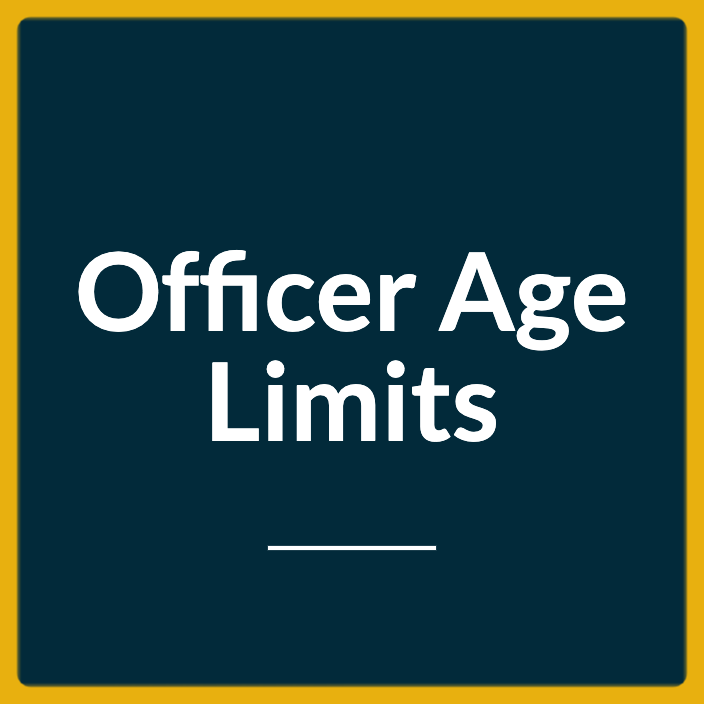This guide provides helpful information for those looking to become a United States Naval Officer during Fiscal Year 2025.
Navy OCS (Officer Candidate School) is one of the primary paths to a commission in the U.S. Navy.
There are many aspects to Navy OCS and knowing these ahead in preparation will provide you with a distinct advantage. So, read and understand the information here to fully prepare for your arrival at Navy OCS.
So let us jump right into the details.
- What is the Navy Officer Candidate School (OCS)?
- The Navy Core Values
- The Eleven General Orders of a Sentry
- What to Expect When Arriving at Navy OCS?
- What to Bring to Navy OCS?
- What NOT to Bring to Navy OCS?
- What to Expect During Navy OCS Training?
- Navy Officer Ranks
- Navy Warrant Officer Ranks
- Navy Enlisted Ranks
- Navy Officer Warfare Devices
- Navy Line and Staff Corps Devices
- Marine Corps Officer Ranks
- Marine Corps Warrant Officer Ranks
- Marine Corps Enlisted Ranks
- Military Phonetic Alphabet and International Signal Flags
- Military Time
- Navy Terminology
- The Articles of the Code of Conduct
- Strictly Prohibited Activities
- Navy Leadership Traits
- Anchors Aweigh (Lyrics)
- The Marines’ Hymn (Lyrics)
- Naval Warfare Principles
- Personnel Qualification Standards
- Navy OCS Physical Fitness Standards
- U.S. Navy Height and Weight Standards
- Physical Fitness Concepts
- Physical Fitness Routine
- Navy PRT Exercises
- More Information
What is the Navy Officer Candidate School (OCS)?
The Navy Officer Candidate School is a training facility at the Officer Training Command in Newport, Rhode Island, where the U. S. Navy provides initial military training to newly selected Unrestricted and Restricted Line Officer candidates.
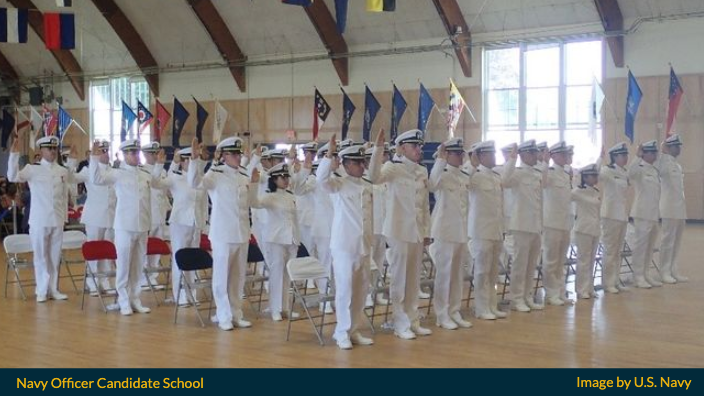
The mission of Officer Candidate School (OCS), a 13-week officer accession program, is to develop civilians, enlisted, and newly commissioned personnel, and imbue them with the highest ideals of Honor, Courage, and Commitment to prepare graduates for service in the fleet as outstanding Naval Officers morally, mentally, and physically.
Division Officer Fundamentals, Engineering and Weapons, Watch Officer (Navigation and Seamanship), Naval History, Leadership and Ethics, Cyber and Damage Control are among the major curriculum subjects.
The 13-week OCS school provides you with a working understanding of the Navy (both on and off the water), to prepare you to undertake the duties of a Naval Officer, and to develop you to your maximum potential.
Navy OCS is both ethically, psychologically, and physically taxing.
At OCS, you will be tested on your own Honor, Courage, and Commitment, and you will be pushed to live up to the highest levels of these basic principles.
The school’s curriculum will put a premium on your academic abilities.
Mental training includes military information memorization, academic courses, and military inspections.
Physical Training (PT) starts as soon as you arrive at OCS.
The physical training program involves both calisthenics and cardiovascular conditioning, as well as track and road running.
Candidates who arrive in poor physical condition and fail the Initial Strength Test (IST) are subject to instant separation from OCS.
So, when people ask: Is Navy OCS hard? The answer is only to those who arrive unprepared. Navy OCS is only easy to pass for people who really want to become Naval Officers.
You will be sworn in by a commissioned officer when you join the US Navy. You will be required to affirm the following oath:
The Navy Core Values
The U.S. Navy is an outstanding professional organization committed to defending our freedom and making sure that America has a safe future.
Navy personnel—both officers and enlisted – have defended the values that have made America the greatest country on earth for over 200 years.
These constant values—Honor, Courage, and Commitment—are referred to as Core Values in the Navy.
All U.S. Navy personnel have a responsibility to be familiar with, comprehend, and faithfully abide by them.
It would be wise to know the Navy Core Values by heart before arriving at Navy OCS.
Honor
“I will bear true faith and allegiance…”
As a result, we will:
- Act in a manner that upholds the highest standards of ethics in all interactions with superiors, peers, and subordinates
- Be truthful and honest in our interactions with one another and with those outside the Navy
- Be willing to make honest recommendations and to accept those recommendations from junior personnel
- Support new ideas and deliver the bad news, even when it is unpopular
- Adhere to an unwavering code of integrity, taking accountability for our actions
We will not stand for illegal, inappropriate, or even the appearance of such activity. We are responsible for both our personal and professional conduct. The honor it is to serve our nation is something that we will be conscious of.
Courage
“I will support and defend…”
As a result, we will:
- Meet challenges while upholding a higher standard of personal conduct and decency
- Have courage to meet the demands of our profession and the mission when it is risky, demanding, or otherwise difficult
- Make decisions in the best interest of the Navy and the nation without consideration for personal consequences
- Be loyal to our country by ensuring the resources entrusted to us are used in an honest, careful, and efficient manner
Commitment
“I will obey the orders…”
As a result, we will:
- Demand respect from everyone in the chain of command
- Be concerned for the safety, professional, personal, and spiritual well-being of our employees
- Treat every person with respect and dignity, regardless of their race, religion, or gender
- Be dedicated to positive change and continuous improvement
- Display the highest level of moral character, technical excellence, quality, and competence in the work we have been trained to do.
One of the most crucial choices you will ever make is whether to join a prestigious organization with a long and illustrious history.
You will be a part of a team that only works as well as its members do their jobs and strive to achieve a shared objective.
The Eleven General Orders of a Sentry
- To take charge of this post and all government property in view.
- To walk my post in a military manner, keeping always on the alert and observing everything that takes place within sight or hearing.
- To report all violations of orders I am instructed to enforce.
- To repeat all calls from posts more distant from the Guardhouse than my own.
- To quit my post only when properly relieved.
- To receive, obey, and pass on to the sentry who relieves me all orders from the Commanding Officer, Command Duty Officer, Officer of the Deck, and Officers and Petty Officers of the Watch only.
- To talk to no one except in the line of duty.
- To give the alarm in case of fire or disorder.
- To call the Officer of the Deck in any case not covered by instructions.
- To salute all officers and all colors and standards not cased.
- To be especially watchful at night, and during the time for challenging, to challenge all persons on or near my post, and to allow no one to pass without proper authority.
Prior to leaving for Officer Candidate School, you must memorize the Eleven General Orders of a Sentry while in the Officer Commissioning Onboarding Program.
What to Expect When Arriving at Navy OCS?
All Candidates, even those with past military service, must report at Navy OCS in civilian clothes by the time specified in their instructions.
Check-in is usually at 0800 on Sunday morning.
Because storage space is restricted at OCS, just a small quantity of civilian clothes should be packed.
Civilian clothing may not be worn while in training or on leave.
During the first week of instruction, you will be provided with the necessary clothing.
When Checking In
When you arrive at Naval Station Newport, ask the gate guard (use Gate 1) for instructions to the OCS check-in area, and then follow the posted signs that say, “OCS Arrivals.”
Check-in will take place in Callaghan Hall. There will be designated parking.
If you arrive in Newport before your allocated report day, you must make your own housing arrangements, since Navy OCS cannot lodge students before their report date.
If you drive, you must have your driver’s license, car registration, evidence of insurance, and a notarized copy of authorization to drive the vehicle if you are not the vehicle’s owner.
On the base, there is designated long-term parking. Typically, you will not have access to your car until OCS graduation.
Personal Mail
You are free to receive and send mail while at Navy OCS. While in training, your address will be as follows.
Please keep in mind that the only variables in the address are your name and class number.
OC (Your Name)
Officer Candidate School
Class XX-XX (Assigned upon arrival)
Officer Training Command Newport
1356 Meyerkord Ave.
Newport, RI 02841
Emergency Issues from Home
In the event of an emergency while you are in training, family members and next of kin may reach you at (401) 862-4321 through the Command Duty Officer.
*NOTE: The caller must say that you are assigned to Officer Candidate School and that they want to report an emergency. The Department of Defense mandates that anybody seeking to contact you do so via their local Red Cross in the case of a medical emergency or death in your immediate family.
Pay and Benefits While in Training
You will be on active duty the moment you leave your residence. You will be paid at the E-5 pay and allowance level, or your existing paygrade if higher.
If you are married and/or have children, the Navy will supplement your E-5 base pay with a tax-free Basic Allowance for Housing (BAH).
If your dependents do not live in the Newport region, you may be eligible for Family Separation Allowance (FSA), depending on your specific scenario.
Leave of Absence
Officer Candidates will only be permitted leave in the event of an emergency.
What to Bring to Navy OCS?
All candidates must ensure they bring all the items listed below. Missing items upon arrival may cause issues with the reporting process.
Administrative Items to Bring
All candidates must bring:
- Official copy of Permanent Change of Station (PCS) orders (or Navy Reserve orders) along with any modifications to the original orders
- Copies of prescriptions from civilian doctors if you are using prescription medicine. You should carry at least two weeks’ supply of medicine with you.
- All medical and dental records, as well as vaccination data (military and civilian)
- A voided personal check to verify proper setup of your military pay direct deposit account
- Two forms of identification documents
- Contact information for the recruiter (name, phone number, fax number, and NTAG address)
- Driver’s license number, car insurance policy number, license plate number, vehicle make and model (if you drove to OCS)
- Bank checks
Prior Active Duty Enlisted Sailors must bring:
- Military Common Access Card (CAC)
- Transfer EVAL from previous command
- Proof of all medals, awards, and unit citations
- SMART transcripts
- Page Two (Record of Emergency Data)
All candidates with prior military service must bring:
- All DD-214s
- All DD-368s
- NGB-22 (National Guard)
- Point capture sheet (Reservists)
- Page Two (Record of Emergency Data)
- Last Personnel Support Detachment (PSD) point of contact information
Collegiate Program participants must bring:
- Military Common Access Card (CAC)
- Page Two (Record of Emergency Data)
- Original or court certified copy of marriage certificate, along with your spouse’s original identification documents. This will be required to add your spouse as your dependent on the system.
- Original or court certified copy of Social Security card and birth certificates for all dependents. This will be required to add your dependents as your official dependents on the system.
- Original child custody documents
- Original Divorce documents
Recommended items to bring (but not required):
- Credit or debit cards
- Book of mail stamps
- List of emergency contacts written on paper
Training Items to Bring
When you arrive at Navy OCS, you will be given all the essential uniform items.
In addition, your rank will determine your clothes allowance (prior Chief Petty Officers will not receive this, as they already receive an allowance).
The materials required to train are listed below. Bring only what is specified.
Male candidates should bring:
- 7 pairs of white socks
- 7-10 sets of white underwear and briefs
- At least one white towel and one washcloth
- Personal Toiletries – Only the Essentials (Full size, not travel size)
- Shaving gear with replaceable blades (6 weeks’ worth)
- Toothbrush/paste and floss
- Deodorant
- Soap/Shampoo
- Nail clippers
Female candidates should bring:
- White basic underwear: 7-10 pairs
- 3 regular bras NOT sports bra (one white or skin tone bra to be worn with white uniforms)
- 5 sports bras (white)
- Conservative one-piece swimsuit (Black/Navy Blue)
- At least one white towel and one washcloth
- Personal Toiletries – Only the Essentials (Full size, not travel size)
- Products for Feminine Hygiene
- Toothbrush/paste and floss
- Deodorant
- Soap/Shampoo
- Make-up and hair products (gel/mousse/hairspray) may be brought but will not be permitted until the last session of training.
- Hairbrush
- Nail clippers
All candidates should bring:
- Glasses: A sturdy pair with a black/brown strap to use while exercising. When you finish your physical check-in, you will be given a government set of glasses. Do not forget to bring your eyeglasses.
- Contact lenses: Typically, they may not be worn until the last period of training.
- Running shoes: On check-in day, you will be suited for and given a pair of running shoes. As a backup, carry a recent pair of running shoes. Minimalist footwear is not permitted.
Optional to bring:
- Alarm clock
- Cell Phones with charger (after week 9)
- Wristwatch (black only)
- Wallet, checkbook, and bank card
- Females only: Gold ball stud earrings (after week 9)
What NOT to Bring to Navy OCS?
Do not bring the following items to Navy OCS. You will not need them and will not be allowed to use them.
All candidates should not bring:
- Any sporting gears
- Personal blankets
- Technological equipment (Kindles, iPads, laptops, video game consoles, and so forth)
- Over-the-counter medicine
- Weapons are all prohibited (including edged, pointed, and impact weapons, pocket knives, and letter openers)
- All aerosol canisters
- Aftershave/cologne
- Hair care items containing grease
- Lighter fluid • Matches
- Non-Navy books and periodicals (religious articles are permitted)
- Cards, dice, gambling paraphernalia
- Large and bulky stationery
- Large plastic picks, rakes, etc., or anything made of metal
- Cigarettes, e-cigarettes, vapes, cigars, pipes, tobacco, chewing tobacco
- Deodorants greater than three ounces
Non-prescription medicines and medications will be seized and destroyed. These include, but are not limited to:
- Antihistamines
- Motion Sickness medication
- Acne medication
- Commercial sleeping aides
- Decongestants
- Eyewash
- Analgesics
- Sex-related materials excluding diaphragms and condoms
- Phisoderm, Phisohex, and other similar products
Candidates should never bring dangerous items, such as:
- Firearms, ammunition
- Fireworks
- Clubs, batons, and brass knuckles
- All straight razors and knives with blades longer than 3 inches (knives and blades less than 3 inches in length, ice picks and scissors should be left home)
- Narcotic substances and any drug-related paraphernalia such as roach clips, hash pipes, and hypodermic needles
Drugs and Alcohol Policy
The U.S. Navy maintains a zero-tolerance policy on illicit substances and alcohol misuse.
A positive drug test for illicit substances will cause your discharge and disqualification from future enrollment.
Those who test positive for alcohol will be evaluated for dependence and may be discharged from the military.
What to Expect During Navy OCS Training?
Students/candidates have little spare time in the OCS program.
A typical daily routine is:
| Time | Activity |
| 0500-0700 | Reveille, PT, Hygiene, Breakfast |
| 0700-1130 | Drill / Academics |
| 1130-1230 | Lunch |
| 1230-1700 | Drill / Academics |
| 1700-1800 | Dinner |
| 1800-2100 | Study |
| 2100-2200 | Hygiene, Preparations, Taps |
Duties and Awards
Someone needs to perform the chores in any organization, whether at home with your family or aboard a ship.
The job is known as “sweepers” at Navy OCS. Sweepers do deck swabbing, facility upkeep, grass care, snow removal, and other tasks to ensure that all employees have a comfortable living environment.
Your class will compete for a variety of awards during OCS, including those for physical abilities, scholastic accomplishment, military drill, personnel inspections, and overall excellence.
The winning classes get Guidon streamers. They march in formation and attend different occasions with the Guidon to signify their accomplished standing.
Military Pay
Everyone in the Navy gets paid twice a month by direct deposit to their preferred banking institution.
To make this happen, you must bring a previously completed Direct Deposit Sign-Up Form, Standard Form 1199A, to Navy OCS.
This form is available at most banks. Section 3 of the 1199A must be completed by the financial institution before your departure for OCS. Bring your checkbook and your ATM card for your account.
Military Leave
While in active service, leave (approved vacation) is earned at a rate of 2.5 days each month. Leave is only permitted for emergencies while in training at Navy OCS.
Academics
Navy OCS should prepare you for a career as a commissioned officer by providing you with a fundamental understanding of military, academic, and nautical disciplines.
It will foster moral, mental, and physical growth, as well as impart the greatest principles of Honor, Courage, and Commitment.
The training you get at OCS is organized into the following major instructional units:
Leadership and Ethics
You will take part in a variety of case studies to hone your decision-making abilities, apply leadership and principles, and explore ethical quandaries that Naval Officers and leaders may confront while carrying out their tasks and obligations.
Division Officer Fundamentals
You will be taught the many requirements and programs needed to carry out your obligations as a Division Officer, including taking part in simulations that put the applicant in real-world circumstances where they must respond to various leadership and people’s difficulties.
Suicide Awareness and Prevention, Fraternization, Hazing, Sexual Assault Prevention and Readiness (SAPR), Command Managed Equal Opportunity (CMEO), Operational Risk Management (ORM), Navy E-Learning, Personally Identifiable Information (PII), GI Bill, and the Fleet and Family Support Center will be among the topics covered.
Watch Officer
This section introduces you to nautical vocabulary, equipment, and deck activities. You will learn how to operate the maneuvering board and how it helps with shipboard watch-keeping.
Chart work, the study of Navigational Aids, and understanding of the Rules of the Road comprise navigation training.
You will be expected to interpret charts and map simulated ship movements and locations at sea.
These abilities will also be tested in a Conning Officer Virtual Environment simulator.
Damage Control
Through hands-on training, the damage control curriculum acquaints you with firefighting and flooding controls.
You will be able to directly tackle flames and floods with the assistance of your damage control team at the Firefighting Trainer and Wet Trainer.
Engineering and Weaponry
The essentials of naval propulsion plants, auxiliary systems, and electrical distribution will be covered.
You will also learn about naval radars, underwater sound transmission, electronic warfare, and weaponry.
Cyberwarfare
To prepare for the future conflict, you will be exposed to the intelligence community, defensive cyber procedures, naval network architecture, and offensive cyber tactics.
U.S. Naval History
You will learn about US naval history from the Revolutionary War to the present. Major US Navy military campaigns, the advancement of Navy technology and tactics, and combined warfare actions will be prioritized.
Students will also study fundamental military rank structure, naval traditions and etiquette, the Chain of Command structure, components of naval strategy, distinct battle theaters, naval doctrine and platforms, and current global threats.
You will also learn about several administrative components of becoming a Naval Officer, such as records, promotion, classified information handling, career development, and compensation.
Finally, students will learn about the Military Code of Conduct, the Uniform Code of Military Justice, investigations, Non-Judicial Punishment, Courts-Martial proceedings, and administrative discharges.
Military Training
The military training categories at Navy OCS are:
Physical Training (PT)
In Navy OCS, there are four Physical Fitness Assessments (PFAs): the Initial Strength Test (IST), the In-PFA, the Mid-PFA, and the Out-PFA.
Passing criteria for each event on the IST are Satisfactory Medium; passing standards gradually rise for each consecutive assessment.
Room, Locker, and Personnel Inspections (RLP)
A candidate’s room may be inspected at any moment. Candidates must be able to maintain uniform and room standards, as well as pay attention to detail and keep information.
Personnel Inspection (PI)
Each candidate’s uniform, haircut, shave, education, cleanliness, and overall military look will be scrutinized.
Military Drill
Drill is learned and practiced for several hours. Training concludes in a graded drill competition in which your drill performance will be assessed.
Battle Stations—Navy OCS Culminating Training Event
In a tough and long final examination, candidates will be put through a series of demanding exercises designed to evaluate their mental, physical, and leadership qualities.
Swim Qualifications
When you arrive at Navy OCS, you must pass the Navy’s approved Standard Basic Swimming Test for Swimmer Third Class. Your examination will take place in a monitored and regulated atmosphere.
Candidates who are deemed hazardous in the water will be withdrawn from training and given remedial swimming lessons.
Candidates who cannot pass the swim test after considerable remedial coaching will be considered for expulsion from the program.
It is critical that you come to OCS prepared to pass this exam. (Speak with your recruiter about how to complete this pre-employment training.)
Third Class Swim Test comprises the following events:
- Abandon Ship Jump – Candidates must jump from a 3-meter tower to simulate abandoning ship.
- 5-minute Prone Float – Candidates must stay afloat face down, using survival floating skills, for five minutes.
- 50-yard swim – Candidates must swim 50 yards using any single following stroke or combination of the breaststroke, crawl, sidestroke, and elementary backstroke.
Safety Note: The swimmer must appear safe, calm, and relaxed during all swim qualification events
Navy Officer Ranks
Ensign—O-1 (ENS)
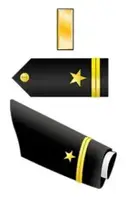
In the United States Navy, an O-1 is an Ensign. His or her insignia is a one-gold bar collar device, or a one-half-inch gold stripe outboard of a one-half-inch gold five-pointed star on black shoulder boards, or a one-half-inch gold stripe below a one-half-inch gold five-pointed star on service dress blue uniform sleeves.
Lieutenant Junior Grade–O-2 (LTJG)
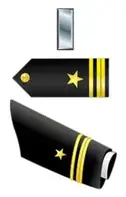
In the United States Navy, an O-2 is a Lieutenant Junior Grade. His or her insignia comprises a single silver bar collar device, or a 1/2-inch gold stripe outboard of a 1/4-inch gold stripe outboard of a gold five-pointed star on black shoulder boards, or a 1/2-inch gold stripe below a 1/4-inch gold stripe below a gold five-pointed star on service dress blue uniform sleeves.
Lieutenant—O-3 (LT)
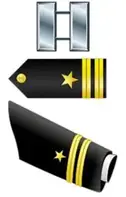
A Lieutenant in the United States Navy is an O-3. His or her insignia comprises two silver bar collar devices, or two 1/2-inch gold stripes outboard of one gold five-pointed star on black shoulder boards, or two 1/2-inch gold stripes below one gold five-pointed star on service dress blue uniform sleeves.
Lieutenant Commander—O-4 (LCDR)
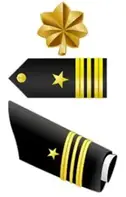
A Lieutenant Commander in the United States Navy is an O-4. His or her insignia is a one-gold oak leaf collar device, or a one-half-inch gold stripe outboard of a one-quarter-inch gold stripe outboard of a one-half-inch gold stripe outboard of a one-half-inch gold stripe outboard of a one-half-inch gold stripe outboard of a one-half-inch gold stripe outboard of a one-half-inch gold stripe outboard of one-half.
Commander—O-5 (CDR)
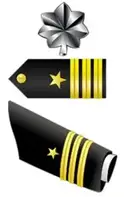
A Commander in the United States Navy is an O-5. His or her insignia comprises a single silver oak leaf collar device, three 1/2-inch gold stripes outboard of a single gold five-pointed star on black shoulder boards, or three 1/2-inch gold stripes below a single gold five-pointed star on service dress blue uniform sleeves.
Captain—O-6 (CAPT)
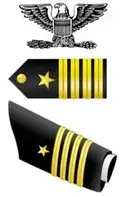
A Captain in the United States Navy is an O-6. His or her insignia comprises a single silver eagle collar device, four 1/2-inch gold stripes outboard of a single gold five-pointed star on black shoulder boards, or four 1/2-inch gold stripes below a single gold five-pointed star on service dress blue uniform sleeves.
Rear Admiral (Lower Half)—O-7 (RDML)
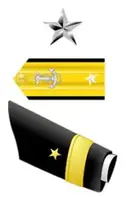
A Rear Admiral in the United States Navy is an O-7 (Lower Half). His or her insignia comprises a single silver five-pointed star collar device, or a single silver five-pointed star outboard of a single silver fouled anchor on gold shoulder boards, or a single two-inch gold stripe under a single gold five-pointed star on service dress blue uniform sleeves.
Rear Admiral (Upper Half)—O-8 (RADM)
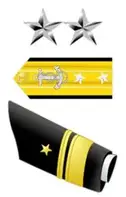
A Rear Admiral in the United States Navy is an O-8 (Upper Half). His or her insignia comprises a two-silver five-pointed star collar device, or two silver five-pointed stars outboard of one silver fouled anchor on gold shoulder boards, or one two-inch gold stripe beneath one 1/2-inch gold stripe beneath one gold five-pointed star on service dress blue uniform sleeves.
Vice Admiral—O-9 (VADM)
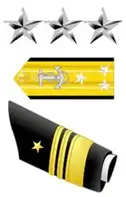
A Vice Admiral in the United States Navy is an O-9. His or her insignia is a collar device with three silver five-pointed stars, or three silver five-pointed stars outboard of one silver fouled anchor on gold shoulder boards, or one two-inch gold stripe below two 1/2-inch gold stripes below one gold five-pointed star on service dress blue uniform sleeves.
Admiral—O-10 (ADM)
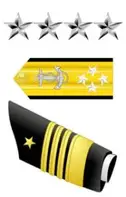
An Admiral in the United States Navy is an O-10. His or her collar device is a four silver five-pointed star, or four silver five-pointed stars outboard of one silver fouled anchor on gold shoulder boards, or one two-inch gold stripe below three 1/2-inch gold stripes below one gold five-pointed star on service dress blue uniform sleeves.
Fleet Admiral—O-11 (FADM)
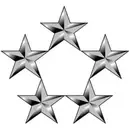
A Fleet Admiral in the United States Navy is an O-11. His or her insignia comprises a collar device with five silver five-pointed stars, or five silver five-pointed stars outboard of one silver fouled anchor on gold shoulder boards, or one two-inch gold stripe below four 1/2-inch gold stripes below one gold five-pointed star on service dress blue uniform sleeves.
Navy Warrant Officer Ranks
Warrant Officer 1—W-1 (WO1)

A Warrant Officer1 is a W-1 in the United States Navy (WO1). His or her insignia comprises a single bar collar device with a blue backdrop and one gold break, or a gold 1/4-inch stripe with three blue breaks on a black shoulder board or a service dress blue uniform sleeve.
Chief Warrant Officer 2—W-2 (CWO2)
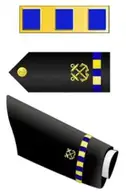
A W-2 is a Chief Warrant Officer 2 in the United States Navy (CWO2). His or her insignia comprises a single bar collar device with a blue backdrop and two gold breaks, or a gold 1/2-inch stripe with three blue breaks on a black shoulder board or a service dress blue uniform sleeve.
Chief Warrant Officer 3—W-3 (CWO3)
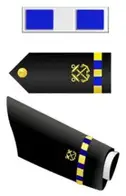
A CWO3 is a W-3 in the United States Navy. His or her insignia comprises a single bar collar device with a blue backdrop and one silver break, or a gold 1/2-inch stripe with two blue breaks on a black shoulder board or a service dress blue uniform sleeve.
Chief Warrant Officer 4—W-4 (CWO4)
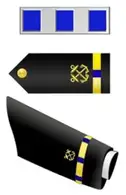
A CWO4 is a W-4 in the United States Navy. His or her insignia is a single bar collar device with a blue backdrop and two silver breaks, or a gold 1/2-inch stripe on a black shoulder board or the service dress blue uniform sleeve.
Chief Warrant Officer 5—W-5 (CWO5)
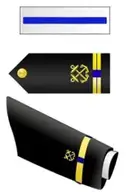
A CWO5 is a W-5 in the United States Navy. His or her insignia is a single bar collar device with a silver background and a horizontal blue line on a black shoulder board or the service dress blue uniform sleeve, or a gold 1/2-inch stripe with a horizontal line and a blue break on a black shoulder board or the service dress blue uniform sleeve.
Navy Enlisted Ranks
Seaman Recruit—E-1
A Seaman Recruit is an E-1 in the United States Navy. He or she wears no insignia.
Seaman Apprentice—E-2
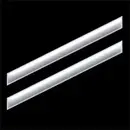
A Seaman Apprentice is an E-2 in the United States Navy. His or her insignia comprises two parallel diagonal slashes.
Seaman—E-3
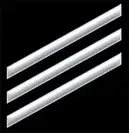
A Seaman is an E-3 in the United States Navy. His or her insignia comprises three parallel diagonal slashes.
Petty Officer Third Class—E-4
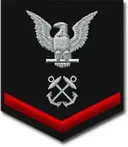
In the United States Navy, an E-4 is a Petty Officer Third Class. His or her insignia comprises one chevron under one eagle.
Petty Officer Second Class—E-5
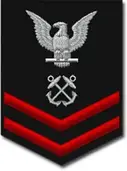
A Petty Officer Second Class in the United States Navy is an E-5. His or her insignia comprises two chevrons under one eagle.
Petty Officer First Class—E-6
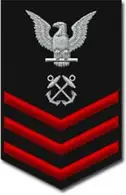
A Petty Officer First Class in the United States Navy is an E-6. His or her insignia comprises three chevrons under one eagle.
Chief Petty Officer—E-7
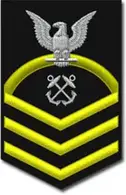
A Chief Petty Officer in the United States Navy is an E-7. His or her insignia comprises three chevrons under one rocker beneath one eagle. The insignia will be a gold fouled anchor collar device with a silver USN overlaid across the anchor in khaki clothing.
Senior Chief Petty Officer—E-8
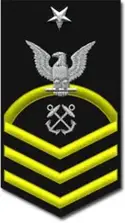
A Senior Chief Petty Officer in the United States Navy is an E-8. His or her insignia comprises three chevrons under one rocker beneath one eagle, beneath one star centered above the eagle. The insignia will be a gold fouled anchor collar device with a silver USN placed over the anchor below one silver star in khaki clothing.
Master Chief Petty Officer—E-9
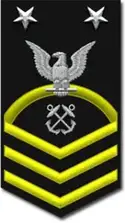
In the United States Navy, an E-9 is a Master Chief Petty Officer. His or her insignia comprises three chevrons under one rocker beneath one eagle, beneath two stars centered above the eagle. The insignia will be a gold fouled anchor collar device with a silver USN placed over the anchor below two silver stars in khaki clothing.
Master Chief Petty Officer of the Navy—E-9
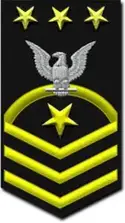
The Master Chief Petty Officer of the Navy is an E-9. His or her insignia comprises three chevrons under one rocker beneath one eagle beneath three stars centered above the eagle. The insignia will be a gold fouled anchor collar device with a silver USN placed over the anchor below three silver stars in khaki clothing.
Navy Officer Warfare Devices
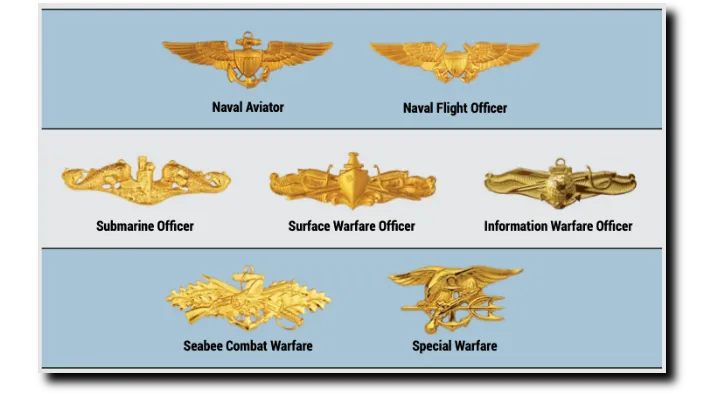
Navy Line and Staff Corps Devices
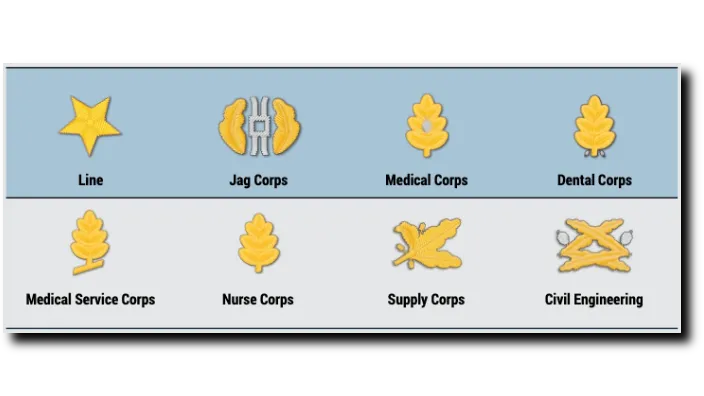
Marine Corps Officer Ranks
Second Lieutenant—O-1 (2ndLt)

A Second Lieutenant in the United States Marine Corps is a 0-1. His/her insignia comprises a single gold bar collar device.
First Lieutenant—O-2 (1stLt)

A First Lieutenant in the United States Marine Corps is a 0-2. His/her insignia is a collar device with one silver bar.
Captain—O-3 (Capt)
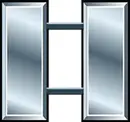
A Captain in the United States Marine Corps is a 0-3. His/her insignia is a collar device with two silver bars.
Major—O-4 (Maj)
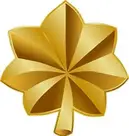
A Major in the United States Marine Corps is an 0-4. His/her collar device is a single gold oak leaf.
Lieutenant Colonel—O-5 (LtCol)
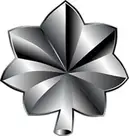
A Lieutenant Colonel in the United States Marine Corps is a 0-5. His/her insignia is a collar device with one silver oak leaf.
Colonel—O-6 (Col)

A Colonel in the United States Marine Corps is a 0-6. His/her insignia is a collar device with one silver eagle.
Brigadier General—O-7 (BGen)
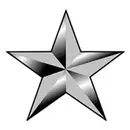
A Brigadier General in the United States Marine Corps is a 0-7. His/her collar device is a single silver star.
Major General—O-8 (MajGen)

A Major General in the United States Marine Corps is an 0-8. His/her insignia is a collar device with two silver stars.
Lieutenant General—O-9 (LtGen)

A Lieutenant General in the United States Marine Corps is a 0-9. His/her insignia is a collar device with three silver stars.
General—O-10 (Gen)
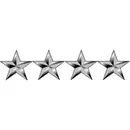
A General in the United States Marine Corps is a 0-10. His/her insignia is a collar device with four silver stars.
Marine Corps Warrant Officer Ranks
Warrant Officer 1—W-1 (WO1)

A WO is a W-1 in the United States Marine Corps. His/her insignia comprises a red bar with one gold break.
Chief Warrant Officer 2—W-2 (CWO2)

A CWO2 is a W-2 in the United States Marine Corps. His/her insignia is a red bar with two gold breaks.
Chief Warrant Officer 3—W-3 (CWO3)

A CWO3 is a W-3 in the United States Marine Corps. His/her insignia comprises a red bar with one silver break.
Chief Warrant Officer 4—W-4 (CWO4)

A CWO4 is a W-4 in the United States Marine Corps. His/her insignia comprises a red bar with two silver breaks.
Chief Warrant Officer 5—W-5 (CWO5)

A CWO5 is a W-5 in the United States Marine Corps. His/her insignia is a silver bar with a horizontal red line.
Marine Corps Enlisted Ranks
Private—E-1
A Private in the United States Marine Corps is an E-1. He or she wears no insignia.
Private First Class—E-2 (PFC)
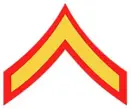
A Private First Class in the United States Marine Corps is an E-2. His/her insignia is a single chevron.
Lance Corporal—E-3 (LCpl)
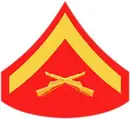
A Lance Corporal in the United States Marine Corps is an E-3 His/her insignia is a chevron with crossed rifles.
Corporal—E-4 (Cpl)
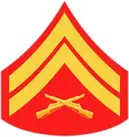
A Corporal in the United States Marine Corps is an E-4. His/her insignia comprises two chevrons crossed by rifles.
Sergeant—E-5 (Sgt)
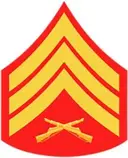
A Sergeant in the United States Marine Corps is an E-5. His/her insignia comprises three chevrons crossed by weapons.
Staff Sergeant—E-6 (SSgt)
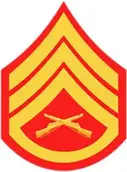
A Staff Sergeant in the United States Marine Corps is an E-6. His/her insignia comprises three chevrons above crossed weapons on one rocker.
Gunnery Sergeant—E-7 (GySgt)
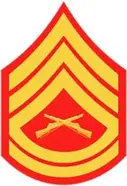
A Gunnery Sergeant in the United States Marine Corps is an E-7. His/her insignia comprises three chevrons crossed by two rockers.
Master Sergeant—E-8 (MSgt)
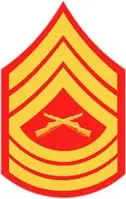
A Master Sergeant in the United States Marine Corps is an E-8. Three chevrons over crossed rifles over three rockers is his/her insignia.
First Sergeant—E-8 (1stSgt)
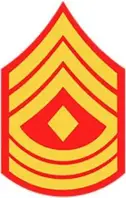
A First Sergeant in the United States Marine Corps is an E-8. Three chevrons above one diamond over three rockers is his/her insignia.
Sergeant Major—E-9 (SgtMaj)
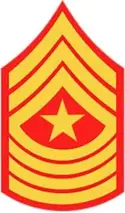
A Sergeant Major in the United States Marine Corps is an E-9. Three chevrons above one star over four rockers is his/her insignia.
Master Gunnery Sergeant—E-9 (MGySgt)
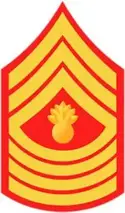
A Master Gunnery Sergeant in the United States Marine Corps is an E-9. His/her insignia comprises three chevrons on top of an exploding bomb on top of four rockers.
Sergeant Major of the Marine Corps—E-9 (SgtMajMC)
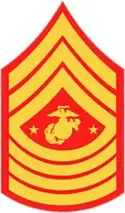
The Sergeant Major of the United States Marine Corps is an E-9. His/her insignia comprises three chevrons above the Marine Corps logo, which are centered between two five-pointed stars on four rockers.
Military Phonetic Alphabet and International Signal Flags
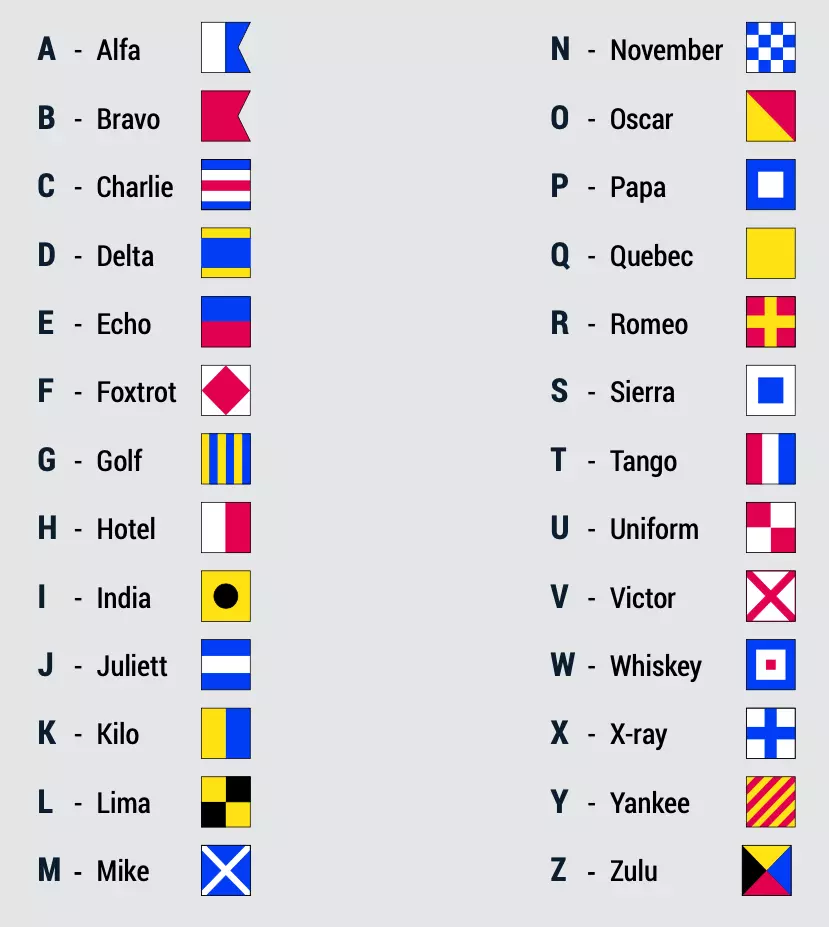
Military Time
The Navy works a 24-hour day. A clock with a 24-hour dial may be seen on board the ship.
The hours of the day are numbered 1-24; at noon, instead of beginning again, the Navy moves to 13.
The times, such as 8 a.m. and 7 p.m., are denoted as 0800 (zero eight hundred) and 1900 (nineteen hundred), respectively.
NEVER USE THE TERM “nineteen hundred hours.”
In the Navy, hours and minutes are calculated: 10:45 a.m. is written as 1045 (ten forty-five), and 9:30 p.m. is written as 2130 (ten forty-five) (twenty-one thirty). To help you understand Navy time, here is a 24-hour dial.
Learn more about this in our Ultimate Guide to Military Time.
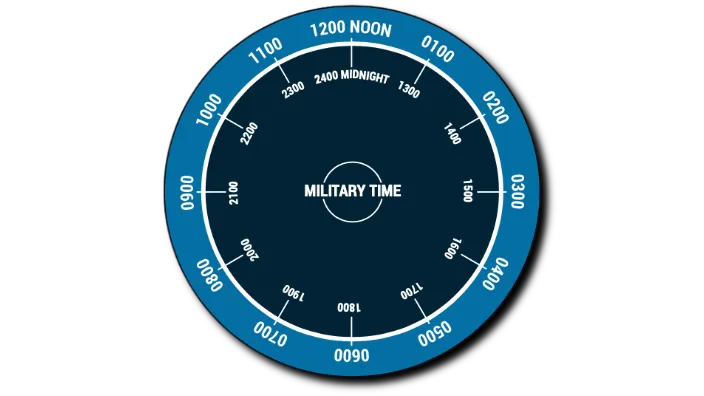
Navy Terminology
The Navy, like every other profession, has its own language. Learning the following Navy words now can help you when you start recruit training.
- ADRIFT: Loose from moorings and out of control (applied to anything lost, out of hand, or left lying about)
- AFT-END: Near or toward the stern of the vessel
- ALL HANDS: The entire ship’s company, both Officer and Enlisted
- ALLOTMENT: An amount of money a member has coming out of his regular pay
- AYE-AYE: Reply to an order or command meaning, “I understand and will comply. “
- BARRACKS: Building where Sailors live BELOW: Downstairs
- BRIGHTWORK: Brass or shiny metal kept polished rather than painted
- BULKHEAD: (wall) a partition or barrier that separates compartments in a ship
- BUNK OR RACK: Bed
- BUOY: An anchored float used as an aid to navigation or to mark the location of an object
- CARRY ON: An order to resume work or duties
- CAST OFF: To throw off; to let go; to unfurl
- CHAIN LOCKER: Compartment in which anchor chain is stowed
- CHIT, CHIT BOOK: Coupon or receipt book
- CHOW HALL (MESS DECK): Place to eat
- COLORS: Raising or lowering of a national flag, ceremonies held at 0800 and sunset for hoisting and hauling down the National Ensign
- DECK: (floor) a platform of horizontal planks or plates spanning across a ship or boat at any of its many levels
- DEEP SIX: To dispose of by throwing over the side
- ENSIGN: National flag; Commissioned Officer between the rank of Chief Warrant Officer and Lieutenant Junior Grade
- FAST: Snugly secured
- FATHOM: A unit of length (equal to 6 feet) used for measuring the depth of water
- FLAG OFFICER: Any Commissioned Officer in pay grade O-7 or above
- GALLEY: Kitchen
- GANGWAY: An opening in a bulwark or lifeline that provides access to a brow or accommodation ladder; an order meaning to clear the way
- GEAR LOCKER: Storage room
- GEEDUNK: Candy, gum, or cafeteria
- GENERAL QUARTERS: Battle stations
- HEAD: Bathroom or toilet
- LIBERTY: Permission to leave the base (usually for not over 48 hours)
- LIFELINE: Lines erected around the weather decks of a ship to prevent personnel from falling or being washed over the side
- OVERHEAD: Ceiling
- PASSAGEWAY or P-WAY: Hallway
- QUARTERS: Assembling of all hands for muster, instruction, and inspection
- RATING: A job specialty title
- REVEILLE: Wake up, start a new day
- SCULLERY: Place to wash dishes
- SCUTTLEBUTT: Drinking fountain; a rumor
- SECURE: Lock, put away or stop work
- SICKBAY: Hospital or Medical clinic
- SWAB: Mop
- TAPS: Time to sleep, end of day
- TATTOO: Five minutes before taps
- TOPSIDE: Upstairs
- TURN TO: Begin work
- WORKING ALOFT: Working above the highest deck; performing maintenance on the ship’s mast
The Articles of the Code of Conduct
- I am an American, fighting in the forces which guard my country and our way of life. I am prepared to give my life in their defense.
- I will never surrender of my own free will. If in command, I will never surrender the members of my command while they still have the means to resist.
- If I am captured, I will continue to resist by all means available. I will make every effort to escape and aid others to escape. I will accept neither parole nor special favors from the enemy.
- If I become a prisoner of war (POW), I will keep faith with my fellow prisoners. I will give no information nor take part in any action which might be harmful to my comrades. If I am senior, I will take command. If not, I will obey the lawful orders of those appointed over me and will back them up in every way.
- When questioned, should I become a prisoner of war, I am required to give my name, rank, service number and date of birth. I will evade answering further questions to the utmost of my ability. I will make no oral or written statements disloyal to my country and its allies or harmful to their cause.
- I will never forget that I am an American, fighting for freedom, responsible for my actions, and dedicated to the principles which made my country free. I will trust in my God and in the United States of America.
Strictly Prohibited Activities
While in training at Navy OCS, candidates are strictly prohibited from engaging in the following activities:
- Motorcycle riding/driving
- Using tobacco, on or off duty
- Application of new tattoos
- Fraternization
- Socializing between candidates and staff
- Dating between candidates
- Private meetings behind closed doors between candidates of the opposite sex
- Public displays of affection or sexual contact between candidates
- Consumption or storage of alcohol in command spaces
- Gambling
- Hazing
- Driving/riding in motor vehicles without the permission of the Class Officer
- Participation in hazardous activities (skydiving, bungee jumping, etc.)
Note: Candidates will be briefed on all prohibited activities during Indoctrination Week.
Navy Leadership Traits
- Judgment
- Justice
- Decisiveness
- Initiative
- Dedication
- Tact
- Integrity
- Endurance
- Bearing
- Unselfishness
- Courage
- Knowledge
- Loyalty
- Enthusiasm
- Honor
Remember them with the help of this mnemonic: JJ did tie buckle H
“A Navy Officer candidate does not lie, cheat, or steal, nor tolerate those who do.”
Anchors Aweigh (Lyrics)
Stand, Navy out to sea
Fight our-battle cry
We’ll never change our course
So vicious foe steer shy-y-y-y
Roll out the TNT
Anchors Aweigh
Sail on to victory, and
Sink their bones to Davy Jones, hooray!
Anchors Aweigh, my boys Anchors Aweigh
Farewell to foreign shores
We sail at break of day-ay-ay-ay
Through our last night ashore, Drink to the foam
Until we meet once more.
Here’s wishing you a happy voyage home!
Blue of the mighty deep
Gold of God’s great sun
Let these our colors be
Till all time be done, done, done, done.
On seven seas, we learn
Navy’s stern call
Faith, courage, service true
With honor, over honor, over all.
The Marines’ Hymn (Lyrics)
From the Halls of Montezuma,
To the Shores of Tripoli;
We fight our country’s battles
In the air, on land, and sea;
First to fight for right and freedom
And to keep our honor clean;
We are proud to claim the title
Of United States Marine.
Our flag’s unfurled to every breeze,
From dawn to setting sun;
We have fought in every clime and place
Where we could take a gun.
In the snow of far-off northern lands
And in sunny tropic scenes,
You will find us always on the job —
The United States Marines.
Here’s health to you and to our Corps
Which we are proud to serve;
In many a strife we’ve fought for life
And never lost our nerve.
If the Army and the Navy
Ever look on Heaven’s scenes,
They will find the streets are guarded
By United States Marines.
Naval Warfare Principles
Levels of War
The strategic level is concerned with achieving national objectives.
The operational level is concerned with the forces in the theater.
The tactical level is concerned with the specifics of particular encounters.
Maritime War
Using decisive offensive force to gain control of the sea is the first step in establishing our hegemony in any territory.
Littoral Warfare
Littoral warfare refers to fighting on land near to the seas that is under the control of and susceptible to the striking power of sea-based forces.
Naval Tactical Mission
- Strike Warfare – Any combination of naval forces aimed at damaging or destroying the target objective.
- Amphibious Warfare – Landing a military force on a hostile coast.
- Electronic Warfare (EW) – Prevent the opponent from using the electromagnetic spectrum effectively.
- Air Warfare (AW) – The activities necessary to neutralize or decrease the enemy’s air and missile threat to a manageable level.
- Undersea Warfare (USW) – Actions made to prevent the adversary from effectively using his submarines and the undersea environment.
- Surface Warfare (SW) – Prevent the opponent from using his surface warships and merchant capacity effectively.
Personnel Qualification Standards
The Commissioning Onboarding Program Personnel Qualification Standards (COP PQS) system guarantees that personnel achieve, demonstrate, and maintain the fundamental knowledge and skill levels required for a seamless transfer from civilian life to entry-level Navy Officer training.
The COP PQS is divided into two phases: training and sign-off.
During the Training Phase, you will be required to study basic facts about the United States Navy.
You will be expected to show—orally and/or physically—knowledge learnt during the training phase during the Sign-Off Phase.
Training Phase
Each module concludes with a list of reference materials for each area.
Your recruiter will offer you with reference materials as needed to help you learn the facts.
At least twice a month, you must meet with your recruiter or authorized COP manager.
Your recruiter will go through this with you in further detail.
Sign-Off Phase
When you have a solid comprehension of a whole module, notify your recruiter.
After successfully verifying your knowledge, your recruiter will sign off on your credentials for that module.
COP PQS completion is the first stage in your Navy Training and your first professional certification.
Navy OCS Physical Fitness Standards
The Navy values a physically healthy body as much as a good intellect.
The goals of Navy OCS’s physical training sessions are to increase stamina and endurance while also improving your general physical condition so that you can satisfy challenging physical fitness requirements.
These goals are largely achieved via the use of calisthenics and a cardiovascular program that includes track and road running.
Physical training starts practically soon after arrival.
During your first week at OCS, you will be expected to take a physical fitness assessment (PFA).
The PFA consists of as many push-ups as you can do in two minutes, a forearm plank (length varies according to age), and a 1.5-mile run.
You should arrive in the finest physical condition possible.
The greater your physical condition, the less likely you are to get an injury. It is strongly advised that you plan ahead of time.
Navy Physical Readiness Test (PRT) Standards
Failure to meet any of the requirements listed below results in an unsatisfactory overall performance for the PRT.
PRT failure may cause immediate termination from the program or the addition of remedial physical training to your already difficult daily regimen.
Male and Female: Age 20—24 Years
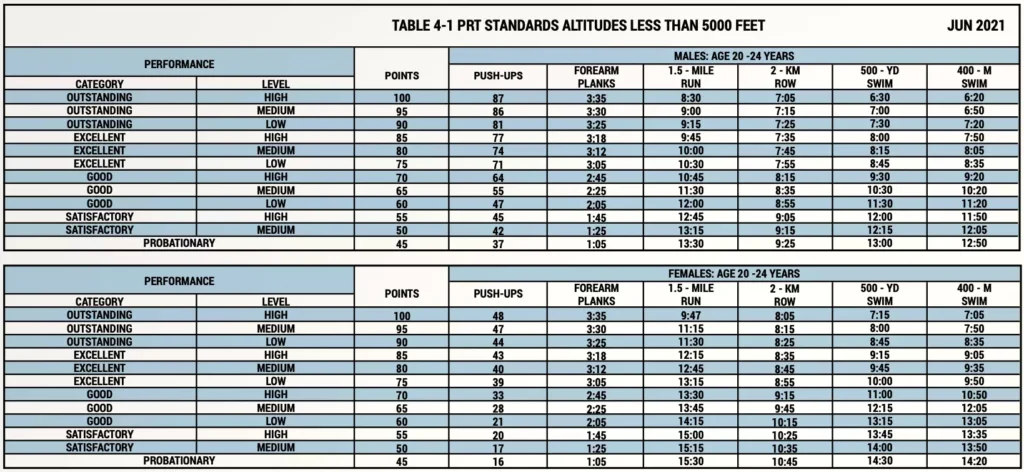
Male and Female: Age 25—29 Years
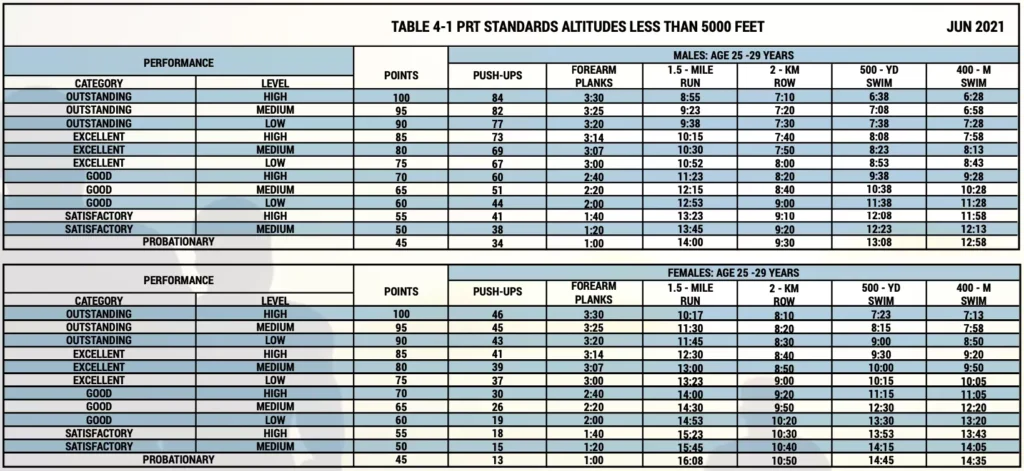
U.S. Navy Height and Weight Standards
Maintaining a sharp, military appearance is difficult if one does not maintain a healthy weight.
Body-fat percentage is used by the Navy to check if personnel are within normal weight guidelines.
To become a Naval Officer, you must fulfill the Navy’s body-fat standards.
Height and weight parameters are used as a guideline to determine if a body-fat assessment is required.
These height and weight requirements are shown below.
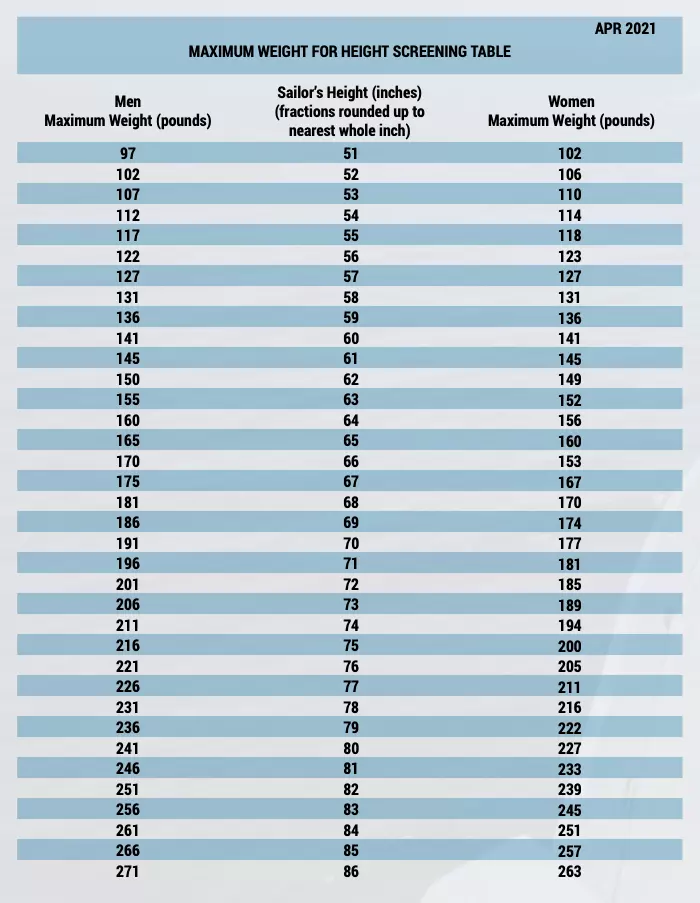
Physical conditioning is required when enrolled in any college program and will be closely monitored and enforced by your Navy Recruiting District.
While in the Delayed Entry Program, physical conditioning programs are optional.
To attain the level of fitness necessary at Navy OCS, you must begin the physical conditioning program specified in this guide.
It is critical to include a warm-up and cool-down in your regimen, as with any physical training program.
Physical Fitness Concepts
Total Body Fitness
Physical fitness refers to an individual’s ability to do both aerobic and strength-related tasks effectively and to keep such capability throughout life.
A physically fit individual possesses cardiovascular endurance, anaerobic capability, muscular strength and endurance, and muscular strength and endurance.
Balanced Training
A well-rounded physical fitness program comprises four key training components: aerobic (cardiovascular), muscular strength and endurance, flexibility, and warm-up/cool-down.
Cardiovascular Conditioning
Building an aerobic basis is the first stage in any training program.
This needs two to four sessions per week of continuous aerobic exercise (e.g., running, brisk walking) at a moderate intensity for 15 to 30 minutes.
Officer Candidates should aim for a heart rate of 130 to 150 beats per minute during exercise, or a perceived effort of “moderately hard.”
Faster is not always better. Running a 12-minute mile or a six-minute mile gives almost the same aerobic and caloric benefit if your heart rate is within the ideal range.
A healthy young adult should create an aerobic basis over four to six weeks.
Muscle Conditioning
Muscle conditioning comprises both strength and endurance exercise.
It should be done on non-consecutive days two to three times a week for specific muscle groups.
Calisthenics are bodyweight workouts that provide resistance. They may build muscular strength and endurance.
Flexibility Training
Joint range of motion is referred to as flexibility. The goal of flexibility training is to create a permanent stretch in the muscles and connective tissues so that the joints may move freely.
Physical Fitness Routine
Stretching
Stretching exercises should ideally be performed BEFORE and AFTER any rigorous physical training. Perform workouts in this order.
- Warm-up
- Stretch
- Exercise
- Cool-Down
- Stretch
Because muscles are most flexible when they are warm, any stretching exercises should always be preceded by a 10-to-15-minute warm-up session (e.g., brisk walk, leisurely jog, mild calisthenics) to reduce the danger of ripping tissues.
Stretching before exercise should be activity specific. For example, if the workout consists mostly of jogging, the lower extremity muscles should be stretched.
Stretches should be gradual and static (no bouncing), maintained for 10 to 20 seconds, taken to the point of tightness rather than discomfort, and executed with a good biomechanical technique for optimal safety and efficacy.
Three to five times a week is the suggested frequency.
Warm-up and Cool-down
The warm-up should:
- Last at least 10 minutes
- Use major muscle groups
- Work your way up to the desired activity (e.g., brisk walking to warm-up running)
The cool-down should:
- last at least 10 minutes
- Use the same major muscle groups as the previous exercise session (e.g., brisk walking to cool down after jogging)
- Finish with stretching activities that target all major muscle groups
A physical training program should contain the following components:
- Two sessions per week of non-consecutive aerobic training
- Two sessions per week of non-consecutive muscular strength and endurance training
- Warm-up and cool-down (including a complete body flexibility routine) before and after each exercise session
Aerobic Conditioning
Warm-Up Exercises (10 to 15 minutes)
- Jumping jacks
- Arm circles
- Brisk walk
- Knee lifts
Aerobic Conditioning Program (15 to 25 minutes)
- Run 1 to 1.5 miles
Cool-down / Flexibility Training (10–15 minutes)
The cool-down should engage the same muscle groups as the prior exercise session in a comparable activity with progressively decreasing intensity (10-15 minutes) (e.g., brisk walking to cool down from running).
The cool-down should culminate with a complete body stretching practice after the cardiovascular system has recovered to a near resting condition (5 to 10 minutes).
Stretch Exercises
All stretches should be done in a static (no bouncing) position and maintained for 10 to 20 seconds.
- Chest stretch – In a standing posture, softly clasp both hands together and put them on the back of your neck. Pull your elbows back slowly until you feel a stretch in your chest. Do not strain your neck or drag your head forward. Caution: This may be done with a partner, but they should not push the stretch by forcibly pulling back on the elbows.
- Posterior shoulder stretch – Gently bring your right arm across your body with your left hand on the rear side of your right arm, above your elbow. A stretch should be felt on the back side of your shoulder and upper arm. Repeat on the other side of your body.
- Triceps stretch – Reach behind your back with your left arm. Gently push back with your right hand on the rear side of your left arm to stretch the left triceps muscle. Repeat on the other side.
- Outer hip and low back stretch – Standing up, softly clasp both hands and put them on the back of your neck. Cross your right leg across the left while sitting in a long sitting posture (legs in front of you, knees straight). Your right foot should be on the ground at around the level of your left knee. Place your left elbow on the outside of your right knee and gently push it to the left side of your body. You should feel a stretch on the outside of your right hip as well as in your low and mid-back. Repeat on the other side.
- Abdominal stretch – Put your hands behind your shoulders while lying on your stomach, then gradually push up until you feel your abdominal muscles being stretched. Do not completely extend your back and lock out your elbows. If you experience any pain in your low back while executing this exercise, use the “propped on elbow” posture to relieve the stress.
- Low back stretch – Pull one or both legs to your chest while laying on your back. You should feel a stretch in your buttocks and low back.
- Piriformis stretch – Cross your right leg across your left thigh while resting on your back (both knees are bent at 90 degrees). Place both hands on the backside of your left leg. Gently lift your right buttock and outside thigh towards your chest until you feel a minor tightness. Repeat on the other side. Seek medical attention if you have low back discomfort after engaging in strenuous activities. This exercise should be done to develop flexibility in this area and may help with pain relief.
- Hip flexors stretch – Place your right foot roughly 3 to 4 feet in front of your left foot in a standing stance (like a lunge). Slowly bend both knees until your body is parallel to the ground. Your left knee should be around 90 degrees. Push your left hip forward gently to feel the stretch in front of your hip. If you do not feel the stretch, tilt your upper body back softly. Repeat on the other side.
- Quadriceps stretch – Standing, with your left knee slightly bent, grip your right ankle with your right hand and keep your balance. Pull your right foot gently towards your buttocks while keeping your knees aligned with the body (make sure the knee is not sticking out and it is directly below your hip). During this quadriceps stretch, you may also stretch your trapezius (neck) muscles by pulling your chin to the opposite side of your chest. Repeat on the other side.
- Modified hurdlers stretch – Pull your left foot towards your groin while sitting in a v-position. Your right leg should be straight but with a small bend at the knee. To stretch your hamstring, gently bend forward and reach for your ankles on your right leg. If you attempt to complete the hamstring stretch while pulling your toes back towards your body, the stretch will be more difficult (versus pointed). Repeat on the other side.
- Groin stretch (butterfly) – Bend both knees and bring the soles of the feet together while sitting with the upper body almost upright and legs straight. Bring your feet closer to your body. Place your hands on your feet and your elbows on your knees gently. Pull your upper body forward slightly while your elbows press down. You should notice a stretch in your groin.
- Calf stretch – In a push-up position, cross your left foot over your right. Gently press the right heel toward the surface with the right knee straight. A stretch will be felt in the right calf. Hold the position for 15 seconds. Repeat on the other side. To avoid low back pain and to improve your core muscles, keep your body in a straight line from your shoulders to your ankle.
Muscle Strength and Endurance Conditioning
Warm-Up Exercises (10 to 15 minutes)
- Jumping jacks
- Arm circles
- Brisk walk
- Knee lifts
Muscle Strength & Conditioning Routine (20 to 40 minutes)
GROUP A
- Push-ups (chest and shoulders)
- Squats (hamstrings, quadriceps, gluteal)
- Toe raises (shin muscles)
- Heel raises (calf muscles)
- Narrow grip push-ups (chest, triceps)
- Front lying chest lifts (backs)
- Trunk curls (abdominal)
GROUP B
- Lunges (hamstrings, quadriceps, gluteal)
- Outer thigh lifts (hip abductors)
- Inner thigh lifts (hip abductors)
- Front lying leg lifts (gluteal)
- Twisting trunk curls (abdominal, oblique)
- Hip rollers (abdominal)
Group A workouts work on all the body’s major muscle groups.
During each planned strength and conditioning session, they should be completed in the sequence specified.
Exercises from Group B may be included for diversity and to boost the training stimulus.
From week one to week eight, the number of workouts sets and repetitions should be steadily increased.
Week one, for example, will comprise two sets of 20 to 30 repetitions of each exercise; week eight will comprise two to three sets of 30 to 50 reps of each exercise.
At the end of each set, you should experience transient muscular tiredness. Rest intervals between sets should last around two minutes.
Cool-down / Flexibility Training (10–15 minutes—same as in aerobic conditioning)
Low Intensity Training
Warm-Up Exercises (10 to 15 minutes)
- Jumping jacks
- Arm circles
- Brisk walk
- Knee lifts
Aerobic Conditioning Program (20 to 40 minutes)
- Run 1 to 1.5 miles
Navy PRT Exercises
Candidates will be tested on the following exercises during the PRT. Practice these prior to arriving at Navy OCS.
Forearm Plank
The Forearm Plank is an excellent core building exercise.
The candidate will begin by lying face down on the deck, elbows bent, forearms flat on the deck, and body in a straight line through the head, shoulders, back, buttocks, and legs.
Elbows must be squarely under the shoulders, at a 90-degree angle between the forearm and upper arm.
Hands cannot be clasped together if the forearms are parallel or angled inward.
Hands and forearms may not be raised off the deck.
Feet should be hip width apart.
The hips must be raised off the surface, leaving just the forearms, wrists, and toes on it.
Knees are straight, pelvis is neutral, and back is flat.
The back, buttocks, and legs must stay straight from head to heels during the exam.
Throughout the test, the head and neck should stay neutral (face straight down at the deck) so that the body remains straight from the head to the heels.
Toes, forearms, and fists or palms must always be in touch with the deck, and hand clasping is not allowed.
No portion of the candidate’s body may come into touch with a vertical support surface.
Push-Ups
Push-ups show upper-body strength (chest, shoulders, and triceps).
To avoid injury and increase core strength and performance, always employ proper technique.
Begin in the relaxed posture. Assume a front leaning stance with your hands shoulder width apart and your feet together.
Straight arms, back, buttocks, and legs from head to heels must be maintained during the push-up.
Begin the push-up by bending your elbows and lowering your complete body until your upper arms are parallel to the surface and your elbows are bent at a 90-degree angle.
Throughout the push-up exercise, maintain the arms, back, buttocks, and legs aligned.
Return to the starting posture by extending the elbows to virtually straighten the arms. Keep your elbows loose.
More Information
If you have questions that are not answered by this guide, contact your Navy Officer recruiter. They will be able to provide you with detailed information regarding Navy OCS.
You may also visit the Officer Training Command website to learn more about Officer Candidate School. Hope you find this comprehensive guide helpful in your pursuit of becoming a commissioned Naval Officer.

